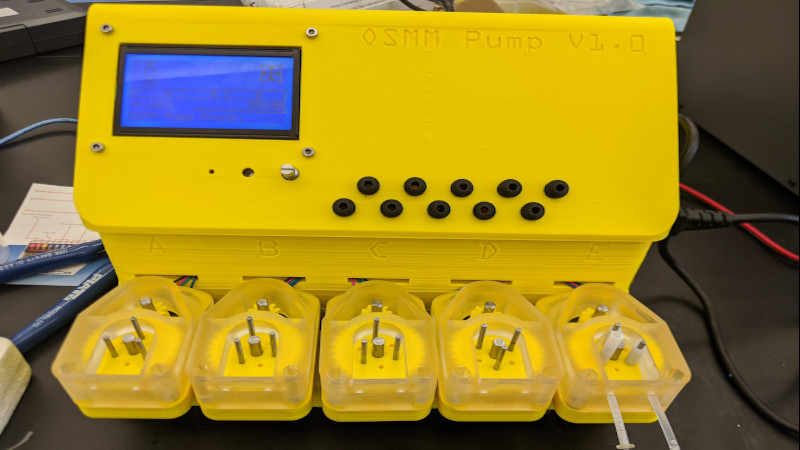When it comes to research in fields such as chemistry or biology, historically these are things that have taken place in well-financed labs in commercial settings or academic institutions. However, with the wealth of technology available to the average person today, a movement has sprung up of those that run advanced experiments in the comfort of their own home laboratory. For those needing to work with very tiny amounts of liquid, [Josh’s] microfluidics pump may be just the ticket.
Consisting of a series of stepper-motor driven pumps, the hardware is inspired by modern 3D printer designs. The motors used are all common NEMA items, and the whole system is driven by the popular Marlin firmware. The reported performance is impressive, delivering up to 15 mL/min with accuracy to 0.1uL/min. That’s a truly tiny amount of fluid, and the device could prove highly useful to those exploring genetics or biology at home.
The great thing about this build is that it’s open source. [Josh] took the time to ensure that it was easily moddable to work with different tubing and materials, such that others could spin up a copy using whatever was readily available in their area. Performance will naturally vary, but if you’re experienced enough to build a microfluidic pump, you’re experienced enough to calibrate it, too. Design files are on Github for those keen to build their own.
We’ve seen other builds in this area before, too. We look forward to seeing some fun science done with [Josh]’s build, and look forward to seeing more DIY science gear in the future!
















If you switch to using a Smoothieboard ( which would likely work as a drop-in replacement to Marlin-based hardware ), you gain the fact that Smoothie’s chip has a RTC, which you can use to be way more accurate in terms of volumes over time. I did some work on this attempting to create syringe pumps when hospitals here in France were critically lacking in them, so if you go this route I can probably give some assistance. wolf.arthur@gmail.com
A few years ago, I’d look at that photo and say “Neat! They 3D printed a case for that, it looks very professional”
Now, I look at those and think “Ugh! Another 3D printed case! Why didn’t they just put it in a milk carton?”
B^)
Bet this would make Elizabeth Holmes cry :-D
This would be useful for watering plants remotely if hooked up to wifi.
So you’re just going to guess from miles away when they need watering? … if you’re going to do it by time, use a timer, if you’re going to have them report how damp/dry they are, use that to trigger it.
I never said I’d guess. I simply didn’t elaborate on an entire setup.
I grow a lot of herbs at home, working on doing an indoor hanging herb garden in my kitchen,, and like the idea of watering and nutrient control hyper regulated through peristaltic pumps. I’d have wifi enabled moisture and oxygen sensors on each plant, accessible from my smartphone, and perhaps a camera or 2 as well on the plants for a visual.
Timer is good enough to keep them alive as native plants outside adapt to the local climate. High yield factory farming requires all the sensors because it is the other way around. Still you’ll need see and feel the plants or have to deal with diseases. Can’t automate that away.
peristaltic pumps need to have the tubing replaced based on the number of cycles they operate, or the tubing can break at an inopportune time. Said in another way, the advantage of that type of pump is the fluids make no contact with the actual pump mechanism, the disadvantage is if it is undesirable for that to happen one likely will keep track of the number of cycles the tubing has undergone and C&D pumping before that happens.
This may be especially so when moving any fluids such as hazardous biological or highly toxic in nature.